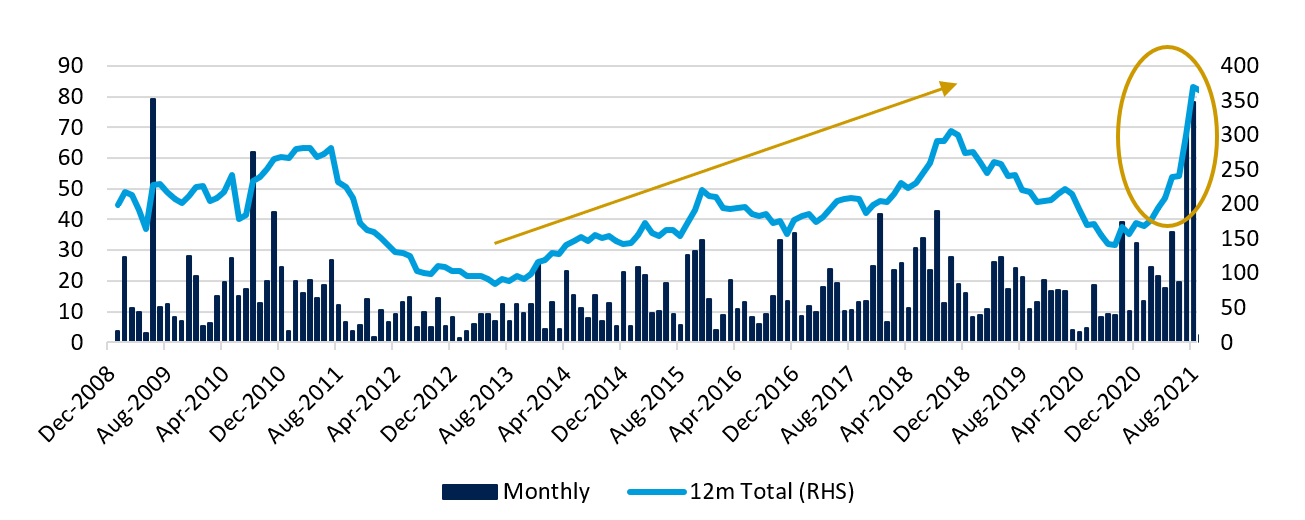The 5 key drivers of the emerging M&A Super-cycle
Since early 2021, we have had the view that we have entered a new Mergers and Acquisition (M&A) super-cycle. In this wire, I will explain why we believe this backdrop is likely to be a powerful tailwind for equity investors, particularly those with a disciplined focus on valuations and identifying strategic or hidden assets.
The last sustained uptick in M&A deal volume started in 2013 and for the subsequent five years, M&A deal volume had strong and consistent growth, as demonstrated in Figure 1.
|
Figure 1: Announced M&A activity involving an Australian Company (A$b) (1) 
Source:
MST Marquee as of 31 August 2021. Since the beginning of the calendar year 2021, Australian companies’ appetite to engage in M&A activity has increased substantially, which has accelerated over the course of the calendar year and remains firmly on a track for continued growth. Major recent deal announcements include:
Interestingly, a high proportion of these transaction announcements involve ASX 100 companies, whereas in previous M&A cycles the deals occurred primarily in the mid and small-cap part of the market. |
It is often stated that there are five drivers of a successful, active M&A market (2):
Let’s explore each driver against the current backdrop.
Economic Recovery
During the start and through the peak of the pandemic, many corporates were focused first and foremost on ensuring they could conduct ‘business as usual’, which created a backlog of M&A deals. Coming into calendar year 2021:
- businesses had bedded down their new ways of working,
- vaccine availability in Australia was on the horizon,
- the decision by corporates to conduct pre-emptive capital raisings and reduce dividends during the initial stages of the pandemic in 2020 meant balance sheets were strong,
- widening valuation differentials between low-growth industrials stocks and assets with infrastructure like characteristics,
- governments and central banks globally were stimulating their economies, and
- strong Global GDP growth in excess of historical levels was emerging.
These factors contributed to much-improved business confidence that a strong economic recovery was going to become a reality and reignited the appetite of business leaders to explore strategic deals.
Flourishing Capital Markets
Capital markets are strongly supportive of M&A at present. With 10-year Treasury yields at historical lows, the access to cheap and readily available debt is a significant enabler of M&A activity.
In equities, many company share prices have rebounded since the March 2020 sell-off. Furthermore, private equity globally and SPACS (Special Purpose Acquisition Companies) which have been going public in large numbers in the US, are both substantial pools of capital that must be deployed in order to generate fees.
Private equity in the Asia Pacific region alone, has approximately US$327 billion of funding waiting to be deployed (3). Finally, superannuation funds and infrastructure funds continue to demonstrate a strong appetite to pursue public-to-private transactions, particularly in the infrastructure and property sectors.
Structural regulatory changes
In early September, the Australian Competition and Consumer Commission (ACCC) announced a sweeping set of proposed reforms to the mergers test and ACCC approval regime.
The reforms seek to consolidate the current multiple approval methods under a single formal merger review process. Any changes will take some time to implement as the Treasury considers the proposals and the Government tests the implications before planning and putting change into motion.
However, this window of time prior to the new regime is a powerful incentive for senior executives to bring forward current planned M&A to avoid a more onerous process. This provides the M&A upswing with further support across the near and medium-term.
Industrial and technological innovation
The onset of the COVID-19 pandemic put pressure on most sectors in the economy, re-shaping the way they operate and bringing forward decisions on corporate strategy and industry consolidation. Many companies and sectors have had to embrace technology in an effort to adapt, with this recalibration presenting alternative methods for operating. The retail and consumer sectors, for example, had to swiftly move in many cases wholly to an online model with significant enhancements to product display and descriptions online, click and collect services, and delivery capabilities.
Need for companies to adapt to changes in the economic environment
ESG considerations as they relate to business models and practises are also reshaping the economic environment and sparking M&A deal flow. A recent example of this would be BHP electing to divest its energy business and sell it to Woodside. Long-term momentum-driven trends such as ESG are driving corporate activity, particularly in coal and other carbon-intensive industries, as well as more broadly.
M&A deal flow creating Catalyst opportunities
We believe the 2021 M&A super-cycle provides a rich opportunity set and a tailwind for fundamental stock-picking. In a market environment that is more conducive to M&A, capital is typically more readily available and there is a higher velocity of potential business combinations.
In turn, as the higher volume of corporate activity occurs, company managements and boards become more cognisant of the potential for unlocking value in their own or other companies, as they realise that if they do not proactively make positive changes in their organisation, someone else may decide to do it for them.
In this way, a strong M&A environment can cause companies to become more receptive to change, which could manifest itself in more openness to bidding for or accepting external M&A deals or for proactively making internally-driven strategic changes to defend or strengthen their businesses.
As such, this market backdrop provides a rich set of strategic options for prospective buyers of companies or assets, and more rapid, easier and higher certainty of deal execution. Each of these aspects of an upswing in the M&A super-cycle enriches the opportunity set for stock selection and is very supportive for the new L1 Capital Catalyst Fund, which launched on 1 July 2021.
Key takeaway
We are now in the first major M&A cycle since 2013
- Driven by improved corporate confidence, cheap debt and private equity.
- Further structural support coming from economic recovery, improved business confidence, structural change in many industries & ESG.
L1 Capital Catalyst Fund
L1 Capital Catalyst Fund is a best ideas, high conviction fund with an activist overlay that focuses on unlocking value in Australian companies to achieve private equity-style returns. This long-only Fund combines the strategic advisory expertise of a dedicated Catalyst team, with the L1 Capital Australian Equities team’s investment management and stock selection capability. Click the 'FOLLOW' button below for more of our insights.
- Source: MST Marquee as of 31 Aug 2021
- Source: ‘M&A Activity: Where Are We in the Cycle?’, CAIA Perspective
- Source: ‘Dealmakers Down Deals Second Quarter M&A Frenzy’, Reuters
10 stocks mentioned

